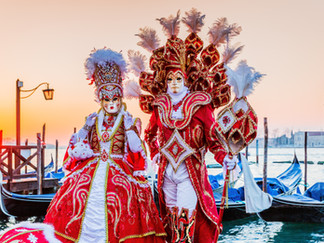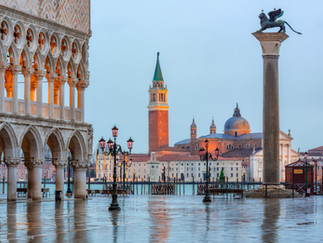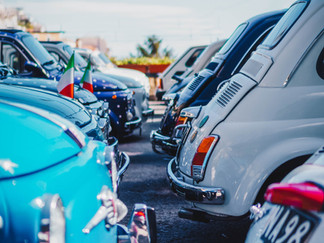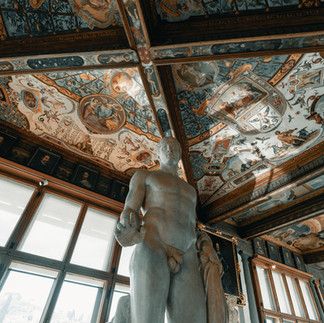TOP OF PAGE
Quick Facts
Best Time To Go
Cost & Spending
Travel Tips
Regions & Highlights
Travel Map
What To See & Do
Itineraries
What To Eat
Hidden Gems
Where To Stay
Trip Planning
ABOUT US

Welcome traveler!
We're Andre & Lisa, adventurers and experienced budget travelers.
We have over two decades of travel experience and since 2018 have led a full-time nomadic lifestyle.
Thank you for visiting and we hope you find value in our destination pages! We thoroughly research and curate all content ourselves and everything you find on this site is put together by only the two of us.

ITALY TRAVEL GUIDE
Italy, a country synonymous with history, art, and gastronomy, invites travellers to embark on a journey through its vibrant culture and stunning landscapes. From the rolling hills of Tuscany to the historic streets of Rome, each region offers a unique tapestry of experiences. Whether you're drawn to the romance of Venice's canals, the ancient ruins of Pompeii, or the fashion capital of Milan, Italy promises an adventure that will captivate your senses and leave you with unforgettable memories.
DO YOU NEED A VISA FOR ITALY?
<<VISA RESULT>>
<< Visa Details >>
For the latest requirements or for application click
Let iVisa take the pain out of travel planning and assist you with Electronic visas, Travel Authorizations, Visas on Arrival, and even Paper Visas. They can also help with Health Declarations and Embassy Registrations. If you're from the US, they provide a One-Stop Shop to renew your Passport securely and error-free.
⬇️ REGIONAL GUIDES ⬇️
TRAVEL GUIDE
TRAVEL GUIDE
TRAVEL GUIDE
TRAVEL GUIDE
TRAVEL GUIDE
TRAVEL GUIDE

⬇️ COUNTRY GUIDE ⬇️

Italy is a country rich in history, culture, and natural beauty. It is one of Western Europe's youngest countries, having unified in 1861, yet it possesses a history that dates back thousands of years with Rome being over 2,000 years old.
Italy has more UNESCO World Heritage sites than any other country, a testament to its profound cultural impact. It's also the birthplace of many scientific advancements; for instance, the battery was invented there, and it's the home of the oldest population in Europe.
Italians consume around fourteen billion espressos annually! Italy is also the world's largest wine producer, emphasizing the country's deep-rooted wine culture

Currency: Italy has the Euro (€) as its sole currency along with 24 other countries.
Electricity: 230V AC electricity. Power outlets are round two-prong sockets (type F which also accepts type C and type E). Be sure to pack a universal travel adaptor so you can still use all your electronic gadgets. If you are from a country with 110V as a standard be aware that you will need a voltage converter.
Visa: Italy is a member state of the European Union and Schengen Agreement. Citizens of EU countries can enter Italy freely on a valid passport or national identity card, while those from many non-EU countries, including Australia, Canada, New Zealand, and the United States, among others, do not need a visa for a stay of up to ninety days. All other nationals should consult the relevant embassy about visa requirements.
Safety: Italy, like most of Europe, is a generally safe country. While violent crime involving tourists is rare, petty theft is not uncommon in all the big cities, on beaches, and at major tourist sights. Tourist scams are most prevalent in bigger cities such as Rome, Milan, or Naples. Make sure that you don’t accept any “gifts” in the form of trinkets, flowers, or bracelets from any vendors. Be stern and respond to them saying "no" or "vai via" ("go away"). Do not help someone “trying to break a large cash note” as this is notoriously fake money. In most places tap water is perfectly drinkable and where it is not, a "NON POTABILE" warning is usually visible. After leaving a restaurant or other commercial facility, it is possible, though unlikely, that you are asked to show your bill and your documents by Guardia di Finanza agents. This is perfectly legitimate (they are checking to see if the facility has printed a proper receipt and will thus pay taxes on what was sold). It's a good idea to review your insurance coverage before you leave to make sure it's adequate. We would suggest checking out either SafetyWing or World Nomads, for travel insurance as they have the best coverage for active travellers.
.
QUICK BOOKING RESOURCES

SEASONS AT A GLANCE
Most destinations have different times of the year when they’re more or less popular with tourists.
Peak Season
Shoulder Season
Off Peak Season
JANUARY
HOT
COLD
MODERATE
DRY
WET
FEBRUARY
HOT
COLD
MODERATE
DRY
WET
MARCH
HOT
COLD
MODERATE
DRY
WET
APRIL
HOT
COLD
MODERATE
DRY
WET
MAY
HOT
COLD
MODERATE
DRY
WET
JUNE
HOT
COLD
MODERATE
DRY
WET
JULY
HOT
COLD
MODERATE
DRY
WET
AUGUST
HOT
COLD
MODERATE
DRY
WET
SEPTEMBER
HOT
COLD
MODERATE
DRY
WET
OCTOBER
HOT
COLD
MODERATE
DRY
WET
NOVEMBER
HOT
COLD
MODERATE
DRY
WET
DECEMBER
HOT
COLD
MODERATE
DRY
WET

BEST TIME TO VISIT ITALY
While you can visit Italy all year round, it’s worth knowing what to expect in each season, especially if you need a particular climate for your travels or if you’re planning on hitting all the top tourist attractions but want to avoid the crowds.
Italy's best travel months are May, June, September, and October. Unfortunately, they can also be the busiest and most expensive time to visit. Crowds aside, these months combine the convenience of peak season with pleasant weather.
The heat in July and August can be gruelling, particularly in the south, where temperatures regularly exceeded 30°C. August is also when many Italians take their summer vacations and the big cities tend to be quiet this time, but beach and mountain resorts are jam-packed. You can also expect the scene in the major historic cities – Rome, Florence, Venice – to be slightly artificial, as the only people around will be fellow tourists.
April & May: Perfect spring weather; ideal for exploring vibrant cities and blooming countryside.
June & July: Summer means beach weather and a packed festival calendar.
September & October: Enjoy mild temperatures, autumn cuisine, and the vendemia (grape harvest).
Between November and April, you can expect cooler weather, and you'll miss most of the sweat and stress of the tourist season - although during major holidays crowds can certainly gather. Off-season, you should expect shorter hours at tourist sights, more lunchtime breaks, and much fewer available activities. During the middle of winter, temperatures often drop to near 0°C in the Milan area and beach towns are nearly shut down.
The best time to visit Italy, in terms of the weather and lack of crowds, is April to late June, and September or October. If you’re expecting beach time and plan to swim, however, bear in mind that only the south of the country is likely to be warm enough outside the May to September period.
BEST TIME FOR:
Italy is home to some of the most stunning beaches in the world, each offering its own unique charm and character. If you’re planning a trip to soak up the sun and enjoy the crystal-clear waters, there are a few noteworthy spots you definitely shouldn’t miss.
First up is the Amalfi Coast, particularly the beaches of Positano and Amalfi. These picturesque towns are famous for their colorful cliffside buildings and breathtaking views. The best time to visit is from late spring to early fall, specifically between May and September, when the weather is warm and the sea is inviting. Just imagine lounging on a beach with a refreshing limoncello in hand!
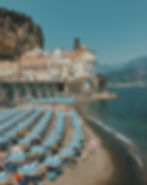
Moving on, we have the stunning beaches of Sardinia, particularly Cala Mariolu and Spiaggia del Principe. These beaches are known for their soft white sands and turquoise waters, making them a slice of paradise. The peak season runs from June to August, but if you prefer a quieter experience, consider visiting in early September when the crowds start to thin out, yet the weather remains delightful.
Don’t forget about Sicily, where you can find the beautiful San Vito Lo Capo. This beach is famous for its fine sand and shallow waters, perfect for families. The best time to visit is from June to September, but if you want to experience the local culture, try to plan your trip around the Couscous Fest in late September.
For something a bit off the beaten path, check out the beaches in Puglia, especially the stunning Porto Selvaggio and Punta Prosciutto. These spots are less touristy, offering a more tranquil experience. The ideal time to visit is in late spring or early fall, when the weather is still warm, but the beaches are less crowded.
Lastly, there’s the enchanting Cinque Terre, where you can find beautiful beaches like Monterosso al Mare. This area is renowned for its dramatic coastal scenery and charming villages. The best time to visit is from late May to early September, when the weather is perfect for hiking between the villages and relaxing on the beach.
Italy’s beaches are not just about sun and sand; they are also a gateway to culture, delicious food, and breathtaking views. However, they can get quite crowded during peak season. To avoid the crowds and still enjoy good weather, the best time to visit Italian beaches is either in June or September. During these months, the weather is warm enough for swimming and sunbathing, but the beaches are less crowded than in July and August.
Additionally, some beaches have implemented measures to preserve their natural beauty, such as capping the number of daily visitors, which makes planning ahead essential.
FIND ALTERNATIVES TO ITALY?
FIND YOUR
PERFECT
DESTINATION
Advanced, real-time destination filter by visa required, region, health risk, travel budget, country value, tourist seasons, best weather and activity or sport.

MORE POSTS ON ITALY

WEWILLNOMAD

WEWILLNOMAD

WEWILLNOMAD
As in every country, you can travel around for as cheap or as expensive as you want. Italy can be one of the more expensive European countries to visit, but how much a visit will cost depends on where in the country you go and when. Much of Italy is little or no more expensive than its Eurozone neighbours, with reasonably priced accommodation and restaurant food. That said, you’ll find the south much less expensive than the north and as a broad guide, expect to pay most in Venice, Milan, Florence, and Bologna, less in Rome, while in Naples and Sicily prices drop quite a lot in comparison. During the height of summer, in July and August when the Italians take their holidays, hotel prices can escalate; outside the season, however, you can often negotiate much lower rates.
Some basics are reasonably inexpensive, such as transport and, most notably, food, although drinking can be pricey unless you stick to local wine. Room rates are in line with much of the rest of Europe, at least in the major cities and resorts. As an indication, you should be able to survive on a budget of about €50–60 per day if you stay in a hostel, have lunchtime snacks and a cheap evening meal. If you stay in a mid-range hotel and eat out twice a day, you’ll spend closer to €130–140 per day. Keep an eye out for workers lunch (pranzo di lavoro) across Italy, these are generally also good value for money and will usually consist of a set menu and drink for the day.

When compared to other European destinations, Italy is less expensive than the UK, Iceland, and Switzerland, but slightly more costly than Spain, Portugal, and Germany. The key to an affordable Italian vacation lies in off-season travel, utilizing budget accommodations, and enjoying the wealth of free cultural experiences available throughout the country.
FIND DISCOUNT FLIGHTS TO ITALY
TRAVEL TIPS FOR ITALY
Unless you opt for a single-base holiday, you will probably find yourself travelling around Italy a fair bit. When planning on how to get around Italy, it is worth considering personal and public transport options.
Most rail and bus services are good value and efficient. Regular ferries service the islands, and local buses link more remote areas. However. especially around the southern parts of Italy, trains can often run well behind schedule and may not be air-conditioned. Internal flights can be worthwhile and even work out cheaper than the train for some of the longer journeys.
We found it easy enough to drive our rather unwieldy campervan around for a few months although we did avoid major cities and for the most part any toll-roads. In rural areas roads can get very narrow and you should allow for enough time to reach your destination than when using major roads. Car rental is easily accessible and might be cheaper than expected.
Buying your own food in Italy can be affordable and the best way to experience the country’s cuisine. The market is your friend, and you will find plenty of bread, cheese, and meat shops around – this is how the locals eat! They go to their markets, buy food, and cook it at home. By visiting a discount grocer like Aldi or Lidl, you will get away for even less.
BUDGET FRIENDLY ACTIVITIES IN ITALY
Italy offers a plethora of budget-friendly activities that allow you to experience the country's rich culture and stunning landscapes without overspending. For instance, you can explore the ancient streets of Rome, where you can visit iconic sites like the Colosseum and the Pantheon for free from the outside. The Trastevere neighbourhood is perfect for enjoying delicious street food and people-watching in a charming setting.
In Venice, while gondola rides can be pricey, wandering through the city's maze of canals and alleyways costs nothing and is an experience in itself. The islands of Murano and Burano are also worth visiting for their colourful architecture and glass-making demonstrations.
If you're interested in art, Florence is home to many galleries that offer free entry or reduced prices on certain days. And for a unique historical experience, the ruins of Pompeii near Naples provide a fascinating glimpse into ancient Roman life at a modest fee.

REGIONS & HIGHLIGHTS OF ITALY
Figuring out where to go in Italy might be the hardest part of your trip! With so much to see and experience, we would recommend you take enough time to explore this alluring country at a slower pace. You can easily find yourself constantly rushing from city to city rather than staying longer and experience a destination in a more unique and authentic way.
Here are some of the main regions worth visiting, along with short descriptions and highlights of each:
TUSCANY
Tuscany, a region in central Italy, is a timeless locale that has captured the imagination of travellers for centuries. Renowned for its rolling hills adorned with vineyards and olive groves, ancient walled towns, and art-rich cities, it is the quintessence of the Italian Renaissance. Visitors are drawn to the cultural heart of Florence, the romantic streets of Siena, and the Leaning Tower of Pisa, while the region's culinary delights and robust wines offer an indulgence for the senses. Tuscany's landscape, culture, and history blend harmoniously, making it an enchanting destination that promises an unforgettable journey through beauty, taste, and tranquillity.
HIGHLIGHTS OF TUSCANY:
Florence: Birthplace of the Renaissance, home to the Uffizi Gallery and Florence Cathedral. Florence hosts the Maggio Musicale Fiorentino, one of the oldest music festivals in Italy, which usually starts in late April and lasts until June. Another significant event is the Scoppio del Carro (Explosion of the Cart) on Easter Sunday.
Siena: Marvel at Siena’s glorious Gothic architecture and Renaissance art. Siena is home to the oldest bank in the world, Monte Dei Paschi, which has been in business since 1472. Sienna is famous for the Palio di Siena, a horse race that takes place twice a year on July 2nd and August 16th.
Chianti: Renowned for its wine, scenic vineyards, and charming villages.
Pisa: Iconic for the Leaning Tower of Pisa.
San Gimignano: Known for its well-preserved medieval towers.
LAZIO

Lazio, the central hub of Italian splendour, offers a tapestry of history and culture interwoven with modern vibrancy. From the ancient ruins of Rome to the serene beaches of the Tyrrhenian Sea, Lazio is a region that boasts an array of diverse attractions. Visitors can explore medieval towns, taste exquisite local cuisine, and immerse themselves in the arts and traditions that have shaped this region for millennia. Whether it's the allure of the Eternal City or the tranquil beauty of its countryside, Lazio promises an unforgettable journey through the heart of Italy.
HIGHLIGHTS OF LAZIO:
Rome: The capital city, featuring the Colosseum, Vatican City, and Roman Forum.Immerse yourself in the grandeur of Rome, a city that boasts an array of awe-inspiring art and iconic monuments. Rome celebrates its birthday, known as Natale di Roma, on April 21st. Another significant event is the Festa della Repubblica on June 2nd, which is a national holiday in Italy.
Tivoli: Home to Villa d'Este and Hadrian's Villa.
Civita di Bagnoregio: A picturesque medieval hill town.
VENETO
Veneto, a region in northeastern Italy, is a tapestry of cultural and natural wonders. From the romantic canals of Venice to the majestic peaks of the Dolomites, Veneto offers a diverse array of experiences. Visitors can explore historic cities like Verona and Padua, enjoy the serene beauty of Lake Garda, or indulge in the region's rich culinary heritage. With its blend of art, history, and stunning landscapes, Veneto is a captivating destination that promises an unforgettable journey into the heart of Italian splendour.
HIGHLIGHTS OF VENETO:
Venice: Embark on a water journey through Venice, cruising past Gothic palaces, domed churches, and crumbling piazzas. Venice is home to over 400 bridges that connect the 118 small islands that make up the city. Venice is famous for its Carnevale di Venezia, a grand celebration that takes place annually between February and March. Another notable event is the Festa della Sensa, a historical celebration on water, typically on the Sunday after Ascension Day.
Verona: Experience an open-air opera in Verona, one of Italy’s most romantic cities. Verona is home to the oldest active university and is known for its towers, churches, and lengthy porticoes. The city is known for the Verona Opera Festival that takes place in the Verona Arena during the summer. Another significant event is the Festa di San Zeno in late April, celebrating the city’s patron saint.
Padua: Home to one of Europe’s oldest universities and the Scrovegni Chapel.
Vicenza: Notable for Palladian architecture.
LOMBARDY

Lombardy, a region brimming with diverse landscapes and rich history, is the epitome of Italian splendour. Nestled at the heart of northern Italy, it's home to the bustling metropolis of Milan, known for its fashion and finance, and the serene beauty of the Italian Lakes. Visitors can explore a tapestry of art, from the masterpieces in Milan's galleries to the frescoes in ancient churches scattered throughout the region. With its alpine peaks and verdant valleys, Lombardy offers a perfect blend of urban excitement and natural tranquillity. Whether you're seeking cultural treasures or outdoor adventures, Lombardy promises an unforgettable journey.
HIGHLIGHTS OF LOMBARDY:
Milan: Italy’s fashion capital, featuring the Duomo, La Scala opera house, and Leonardo da Vinci’s "The Last Supper".
Lake Como: A stunning lake surrounded by mountains and elegant villas.
Bergamo: Known for its medieval Upper Town.
CAMPANIA
Campania, a region where history, art, and culture intertwine with stunning natural landscapes, offers an Italian experience like no other. From the vibrant streets of Naples to the ancient ruins of Pompeii and Herculaneum, Campania is a treasure trove of archaeological wonders. The Amalfi Coast, with its dramatic cliffs and azure sea, beckons travelers seeking breathtaking views and quaint coastal towns. Whether indulging in the rich culinary traditions or exploring the serene islands of Capri and Ischia, Campania promises an unforgettable journey through the heart of Southern Italy.
HIGHLIGHTS OF CAMPANIA:
Naples: Known for its historic centre, lively street life, and proximity to Mount Vesuvius. Naples celebrates the Festa di San Gennaro on September 19th, which is one of the most important religious festivals in Italy. Another notable event is the Pizza Festival that takes place in September.
Pompeii and Herculaneum: Ancient cities preserved by the eruption of Mount Vesuvius.
Amalfi Coast: Famous for its picturesque towns like Amalfi, Positano, and Ravello. The Amalfi Coast is a UNESCO World Heritage Site and is known for its characteristic red buildings. The region hosts the Ravello Festival, an annual summer music and arts festival held in the town of Ravello. Another notable event is the Festival of Sant’Andrea in Amalfi, which takes place on June 27th and November 30th each year.
Capri: An island known for its rugged landscape and upscale resorts.
SICILY

Sicily, the largest island in the Mediterranean Sea, is a tapestry of ancient cultures and modern charm. From the bustling streets of Palermo to the serene beaches of Taormina, the island offers a diverse range of experiences. Visitors can explore the rich history evident in the Greek temples of Agrigento and the Norman cathedrals, or indulge in the island's culinary delights, featuring fresh seafood and the famous Sicilian cannoli. With its stunning landscapes and vibrant culture, Sicily is a destination that captivates the heart of every traveller.
HIGHLIGHTS OF SICILY:
Palermo: The vibrant capital with a mix of Arab, Norman, and Baroque architecture.
Taormina: Renowned for its ancient Greek theatre and stunning views of Mount Etna.
Agrigento: Home to the Valley of the Temples, a UNESCO World Heritage site.
Etna: Europe’s highest and most active volcano.
EMILIA-ROMAGNA
Emilia-Romagna, a region brimming with Renaissance cities, medieval towns, and culinary delights, is Italy's unsung treasure. From the vibrant, historical streets of Bologna, the region's capital, to the serene Adriatic coast, Emilia-Romagna offers a slice of Italian life that's as rich in culture as it is in flavor. Renowned for its gastronomic heritage, including delicacies like Parmigiano-Reggiano and Prosciutto di Parma, this region invites travelers to indulge in a journey that tantalizes the taste buds and captivates the soul. Whether you're exploring the motor valley, home to luxury car makers, or the lyrical landscapes that inspired Verdi, Emilia-Romagna promises an unforgettable Italian experience.
HIGHLIGHTS OF EMILIA-ROMAGNA:
Bologna: Famous for its medieval towers, porticoes, and gastronomy. Bologna is famous for its prestige education and authentic cuisine and hosts the Bologna Jazz Festival in November.
Parma: Known for its prosciutto and Parmigiano-Reggiano cheese.
Modena: Renowned for balsamic vinegar and the Ferrari Museum.
PUGLIA

Puglia, the sun-bleached heel of the Italian boot, offers a journey through a mesmerizing landscape of ancient olive groves, baroque towns, and white-washed trulli houses. Its extensive coastline boasts some of Italy's most pristine beaches and azure waters, inviting visitors to bask in the Mediterranean sun. A tapestry of rich history, Puglia is a treasure trove of culinary delights and cultural gems waiting to be discovered. From the UNESCO-listed Alberobello to the vibrant capital city of Bari, Puglia promises an unforgettable Italian adventure.
HIGHLIGHTS OF PUGLIA:
Alberobello: Famous for its trulli, whitewashed stone huts with conical roofs.
Lecce: Known as the "Florence of the South" for its baroque architecture.
Ostuni: The "White City" with its charming old town.
Gargano Peninsula: Notable for its forests, limestone cliffs, and beach resorts.
PIEDMONT

Nestled in the northwest of Italy, Piedmont is a treasure trove of culinary delights, fine wines, and picturesque landscapes. This region, the second-largest in Italy, is renowned for its Slow Food movement and the majestic Alps that provide a stunning backdrop to its many historical towns and castles. From the truffle-rich hills of Alba to the Barolo and Barbaresco vineyards, Piedmont offers a rich tapestry of cultural and sensory experiences, making it an essential destination for any discerning traveller seeking the quintessence of Italian elegance and gastronomy.
HIGHLIGHTS OF PIEDMONT:
Turin: Known for its baroque architecture, museums, and the Shroud of Turin. Turin hosts the Turin International Book Fair in May, which is one of the largest book fairs in Europe. Another significant event is the Cinema Ritrovato Festival, a film festival dedicated to the discovery and restoration of rare and little-known films, which takes place in June.
Langhe and Monferrato: Famous for wine production, particularly Barolo and Barbaresco.
Lake Maggiore: A scenic lake with charming towns and the Borromean Islands.
UMBRIA
Nestled in the heart of Italy, Umbria is a region steeped in history and natural beauty. Often referred to as the "Green Heart of Italy," it offers a serene escape with its rolling hills, verdant valleys, and medieval hill-towns brimming with artistic treasures. From the sacred grounds of Assisi, home to St. Francis, to the dramatic landscapes of the Valnerina and Monti Sibillini, Umbria invites travellers to explore its mystical charm and rich cultural tapestry. Whether you're seeking tranquillity or adventure, Umbria's timeless allure promises an unforgettable journey.
HIGHLIGHTS OF UMBRIA:
Assisi: The birthplace of St. Francis, with its impressive basilica.
Perugia: A lively hilltop town with medieval architecture and a renowned chocolate festival.
Orvieto: Known for its stunning cathedral and underground caves.
Spoleto: Famous for its summer music and opera festival.
SARDINIA

Sardinia, the second-largest island in the Mediterranean Sea, is a jewel of Italy known for its rugged landscape, pristine beaches, and rich history. Visitors can explore the ancient Nuragic civilization at Su Nuraxi di Barumini, a UNESCO World Heritage site, or enjoy the crystal-clear waters of Cala Gonone and Capo Caccia. With a vibrant culture, delicious cuisine, and diverse natural beauty, Sardinia offers an enchanting escape for travellers seeking both adventure and relaxation.
HIGHLIGHTS OF SARDINIA:
Cagliari: The capital city with a historic centre, Roman amphitheatre, and bustling markets.
Costa Smeralda: A famous stretch of coastline known for its stunning beaches, crystal-clear waters, and luxury resorts.
Alghero: A charming town with Catalan influences, medieval walls, and nearby Neptune's Grotto.
Nuoro: Offers insight into traditional Sardinian culture and is the gateway to the rugged interior.
La Maddalena Archipelago: A group of islands with pristine beaches and excellent opportunities for sailing and diving.
Nora: An ancient Phoenician and Roman archaeological site.
Barumini: Home to Su Nuraxi, a UNESCO World Heritage site featuring a well-preserved nuraghe (a type of ancient megalithic edifice).
Gennargentu National Park: A mountainous area offering hiking, wildlife, and traditional villages.
WHAT TO SEE AND DO IN ITALY
INCREDIBLE EXPERIENCES IN ITALY
THE MUSEUMS OF ROME
Rome is a city that has been frozen in time, full of archaeological treasures and magnificent piazzas that reflect the good old days, yet with all the benefits that a modern and innovative city offers. Rome has no shortage of museums. However, nothing in the city rivals the Vatican museums, home to some of the world’s largest and richest collection of art and culture. You will struggle to see everything in just one visit so the features you really shouldn’t miss are the Raphael Rooms and, of course, the Sistine Chapel, with its world-renowned ceiling frescoes by Michelangelo.
As independent travellers, we usually prefer to have a go at activities ourselves but like most big cities, Rome can be a little bit overwhelming initially. To help you make the most of your time, have a look at a few of our recommended tours.
Skip-the-Line Vatican, Sistine Chapel, St. Peter’s Tour – No trip to Rome would be complete if you don’t visit the Vatican. Immerse yourself in the Vatican's awe-inspiring art with no-wait access to the Sistine Chapel, Vatican Museums and St. Peter’s Basilica.
Tour of the Colosseum, Roman Forum and Palatine Hill – Skip the long lines to the Colosseum, Roman Forum, and Palatine Hill as you follow in the footsteps of Roman emperors and gladiators.
Rome Highlights Segway Tour – Discover the many beautiful sites of Rome in a completely unique way on a guided Segway tour.
DISCOVER VENICE
Venice, the city of canals, is a marvel of engineering and a testament to human ingenuity. Known for its intricate waterways and striking architecture, Venice stands as a unique destination with a rich history that dates back over a millennium.
The heart of Venice lies in its iconic St. Mark's Square, home to the majestic St. Mark's Basilica and the imposing Doge's Palace. These landmarks, along with the famed Rialto Bridge, paint a picture of Venice's past as a powerful maritime republic. The Bridge of Sighs and the Grand Canal further add to the city's historical tapestry, offering glimpses into the daily life of Venetians past and present. Art and culture are deeply ingrained in the Venetian ethos, with the Peggy Guggenheim Collection and the Accademia Gallery Museum showcasing masterpieces that span centuries Venice's contribution to the art world is unparalleled, with its vibrant history reflected in every gallery and exhibition space.

Venetian cuisine is another aspect of the city's rich cultural heritage. Traditional dishes, often featuring locally sourced fish and vegetables, offer flavours that are as complex as Venice's history. The city's streets and markets are also a treasure trove of unique souvenirs, from authentic Murano glass to intricate Burano lace.

Venice is not just a city; it's a living museum, a culinary delight, and a romantic journey. It's a place where every alleyway and canal tell a story, inviting visitors to discover something new with each visit. So, embark on a journey to Venice and let the city's timeless allure captivate your heart. Venice awaits to reveal its secrets to those eager to explore its winding canals and historic streets.
DRIVE THE AMALFI COAST
The Amalfi Coast, with its serpentine roads and breathtaking views, offers one of the most exhilarating driving experiences in the world. The SS163, also known as Amalfi Drive, stretches approximately 50 kilometers along the Italian coastline, presenting drivers with a unique blend of challenges and rewards.
For those considering this adventure, here are some tips to enhance the experience:
Timing is Everything: To avoid heavy traffic, plan your drive during the off-season or early in the morning. The summer months, especially between June and September, are particularly congested.
Vehicle Choice: A smaller car is advisable for easier navigation through the narrow lanes and tight corners. Ensure your vehicle is equipped with a reliable navigation system to assist on the winding route.
Parking Strategy: Parking can be scarce, so if you're staying overnight, confirm that your accommodation provides parking space. During the day, be prepared to park in designated areas and explore the towns on foot.
License Plate Regulations: Be aware of the alternating license plate system which may restrict road access on certain days to reduce congestion.
Safety First: The drive is known for its sharp turns and narrow passages, so drive cautiously and be prepared for the unexpected.
Enjoy the Journey: Don't rush. The Amalfi Coast is lined with picturesque towns and stunning vistas. Take time to stop, explore, and capture memories.
Alternative Transport: If the thought of driving is daunting, consider other modes of transportation such as buses, ferries, or private tours that offer a stress-free way to enjoy the scenery.
HIKE CINQUE TERRE
The Cinque Terre, a string of five historic coastal villages in the Liguria region of Italy, offers one of the most enchanting hiking experiences in the world. The area, recognized as a UNESCO World Heritage Site, is renowned for its rugged coastline, steep terraces, and colourful houses that seem to cascade down to the sea.
For those looking to explore this breathtaking landscape on foot, the Cinque Terre presents a network of trails that weave through vineyards, olive groves, and Mediterranean scrub, offering panoramic views of the Italian Riviera. The most famous path, the Blue Trail, is an 11 km trek that connects all five villages: Riomaggiore, Manarola, Corniglia, Vernazza, and Monterosso al Mare. The trail varies in difficulty, with some sections being easy and paved, while others require a bit more stamina as they climb over hillsides. It takes approximately 5 hours to complete the entire Blue Trail, not including stops to enjoy the scenery and explore the charming towns.

Before setting out, hikers need to purchase a Cinque Terre Card, which provides access to the trails and unlimited train travel between the towns. It's important to note that some parts of the trail may be closed due to maintenance or safety reasons, such as the Via dell'Amore between Riomaggiore and Manarola, which is expected to reopen in July 2024.
Each town along the Cinque Terre trail has its unique character and attractions. From the bustling beaches of Monterosso to the quiet charm of Corniglia, perched high above the sea, there's something for every traveller. Local cuisine, artisan shops, and the warm hospitality of the Ligurian people add to the experience, making a hike through the Cinque Terre not just a physical journey, but a cultural one as well.
For those planning a trip, the best times to visit are during the spring and fall when the weather is mild, and the trails are less crowded. Regardless of when you go, the Cinque Terre is sure to provide a memorable adventure filled with stunning views, physical challenge, and the simple joy of discovering one of Italy's treasures on foot.
SUGGESTED EXPERIENCES:
Cinque Terre Day Tour from Florence – Although staying overnight is recommended, if you are short on time explore the rugged Cinque Terre region of the Italian Riveria on this full-day trip from Florence.
Monterosso: Cinque Terre Kayak Tour – View the stunning Cinque Terre National Park from a unique and exclusive perspective on-board your kayak.
Sailing Tour in the Gulf and Cinque Terre – Enjoy the views of La Palmaria island, Porto Venere, and Cinque Terre National Park on a sailing tour from La Spezia.
SAIL LAKE COMO
Lake Como, nestled in the Lombardy region of Italy, is a haven for sailing enthusiasts and those seeking a tranquil escape. The lake's deep blue waters are surrounded by lush green hills and majestic mountains, creating a picturesque setting for a day of sailing.
Sailing on Lake Como offers a unique opportunity to explore the lake's beauty from a different perspective. With options ranging from small-group tours to private luxury cruises, visitors can choose the sailing experience that best suits their preferences. For a more exclusive experience, private boat tours are available, providing a four-hour journey that includes sights such as Villa Balbianello, Giardini di Villa Melzi, Villa Carlotta, Comacina Island, and the charming towns of Bellagio and Nesso. These tours often depart from Como and offer a luxurious way to witness the grandeur of Lake Como's villas and gardens.
Lake Como's sailing experiences are not just about the journey on the water; they also provide opportunities for stops along the lake for guided walking explorations of the best towns and villas. This combination of sailing and sightseeing offers a comprehensive way to immerse oneself in the culture and history of this stunning Italian destination.
EXPLORE FLORENCE
Florence, the cradle of the Renaissance, is a city that never ceases to amaze and inspire. With its rich history, stunning architecture, and unparalleled art collections, it's a place where every corner tells a story. For those looking to explore the best of Florence, here's a guide to some must-visit spots that embody the essence of this enchanting city.

The Cathedral of Santa Maria del Fiore, commonly known as the Duomo, is the jewel of Florence. Its magnificent dome, engineered by Filippo Brunelleschi, is a testament to the ingenuity of Renaissance architects and offers breathtaking views of the city. Not far from the Duomo, the Baptistery stands as one of the oldest buildings in Florence, famed for its bronze doors that Michelangelo dubbed the "Gates of Paradise".
Art lovers will find their haven at the Uffizi Gallery, home to an extensive collection of Renaissance art, including works by Leonardo da Vinci, Michelangelo, and Botticelli. For a more intimate experience with Michelangelo's work, the Accademia Gallery houses the iconic statue of David, a masterpiece of Renaissance sculpture.
No visit to Florence is complete without a stroll across the Ponte Vecchio, the oldest bridge in Florence, lined with jewellery shops that glitter with gold and precious stones. The bridge leads to the Oltrarno district, where the Palazzo Pitti and the Boboli Gardens offer a glimpse into the grandeur of Medici life.
For those seeking a panoramic view of Florence, Piazzale Michelangelo is the place to be. This scenic square offers a stunning vista of the city's skyline, dominated by the Duomo and the surrounding hills.
Florence is not just about the past; it's a living city with a vibrant culinary scene. From traditional trattorias serving Tuscan specialties to chic rooftop bars offering modern Italian cuisine, there's something to satisfy every palate.
CLIMB THE DOLOMITES
The Italian Dolomites, a majestic mountain range in the northeastern part of Italy, are a paradise for hikers and nature enthusiasts. With their unique jagged peaks and serene valleys, the Dolomites offer an unforgettable experience for those seeking adventure and tranquillity. The Dolomites are not only a UNESCO World Heritage site but also a place where you can find some of the most beautiful and diverse trails in Europe. From the challenging paths that lead to the highest peaks to the leisurely walks around picturesque alpine lakes, there is something for every level of hiker.

One of the most recommended hikes is the Tofana di Mezzo, which offers one of the best views of the Dolomites from a relatively short trail. For those looking for a more challenging adventure, the Alta Via 1 presents an exhilarating experience with detailed maps and instructions available to guide you through.
The best time to hike in the Dolomites is from June through September when the trails are clear of snow and the weather is warm. However, it's important to be prepared for the hike with the right gear, including hiking boots with good ankle support, a waterproof jacket, and plenty of water.
SUGGESTED ITINERARIES
In Italy, everywhere you go you’ll find a culture steeped in history with ancient hilltop towns to modern bustling cities, dramatic mountain landscapes to sweeping coastal scenery and idyllic beaches, each pocket of the country have something different to offer. As if this wasn’t enough, Italy’s world-famous, authentic cuisine and fantastic wines are second to none.
ONE WEEK
A one-week whistle-stop tour of Italy is just barely enough to take in the country's three most famous cities. After a couple of days exploring the unique canal scape of Venice, head south to Florence, Italy's great Renaissance city. Two days will whet your appetite for the artistic and architectural treasures that await in Rome.
TWO WEEKS
After the first week, continue south for some sea and southern passion. Spend a day admiring art in Naples, a day investigating the ruins at Pompeii, and a day or two admiring the Amalfi Coast. Then backtrack to Naples for a ferry to Palermo and the gastronomic delights of Sicily.

WHAT TO EAT IN ITALY
Italian food is as diverse as it is exquisite. With a diverse range of culinary traditions and some of the freshest local ingredients, you can be sure that you’ll have some truly gourmet meals wherever you go in Italy. Don’t be afraid to ask locals for their recommendations; this will usually elicit strong views and sound advice. The importance Italians attach to food and drink makes any holiday in the country a treat.
If you don’t know where to start while in Italy, here are a few dishes that you need to try. They contain their own unique twist of flavours and textures, all mixing into one singular dish that will send your senses to heaven and back.
Risotto alla Milanese - In central-northern Italy, on the plains of the Po river, pasta often takes second place to rice, usually in the shape of risotto, and in the case of Milan, as risotto alla Milanese, whose beauty lies in its golden colour and delicate, saffron-infused flavour.
Pizza - An iconic Italian dish, it would be a crime to visit Italy and not gorge on a traditional pizza! Easy, cheap, and filling, pizza has long been a common snack or meal, especially in Naples where tomato sauce was first added. For a quality, pizza opt for somewhere with a wood-fired oven (forno a legna) rather than an electric one, so that the pizzas arrive blasted and bubbling on the surface and with a distinctive charcoal taste. Simple is best and the most popular choice among locals is the delicious Margarita with a thin and crispy crust.

Ribollita - In Tuscany, this dish is considered a special treat in the autumn! With its roots in the peasant cooking of the region, this vegetable soup is thickened with bread instead of meat, because that is what was cheaper and more readily available for hundreds of years in the desperately poor Italian countryside. Ribollita means “reboiled”, a reference to the fact that in the impoverished past this rich, rustic Tuscan soup of cannellini beans, cavolo nero, carrots, celery and more, was the reheated minestrone of the previous day, but with the addition of stale bread and other inexpensive leftovers and ingredients. You will find few soups to be heartier or tastier.
Ossobuco - The world-famous ossobuco alla milanese is a bone-in veal shank, cooked at low heat until meltingly tender in a broth of meat stock, white wine, and veggies. Traditionally, it’s accompanied by a gremolata (lemon zest, garlic, and parsley). Despite the popularity of ossobuco (which literally means ‘hollow bone’), it’s not always common to see it on restaurant menus because it needs about three hours of cooking time.
Tiramisu - This “pick-me-up” dessert is another now ubiquitous Italian dish, with several cities and regions claiming its invention. If you want to branch out from gelato in the world of Italian sweets, your first stop should be the deceptively simple Tiramisu, which is probably the country’s most beloved after-dinner dessert. What’s not to like about a dangerously sweet and calorie-laden confection of coffee, cocoa, and creamy mascarpone?
Gelato - No trip to Italy is complete without gelato! If you’re tempted to have a scoop (or two) a day don’t worry, it’s totally normal to eat gelato on a regular basis in Italy, especially in the summer.
LGBTQ IN ITALY
I'm a paragraph. I'm connected to your collection through a dataset.

WHERE TO STAY IN ITALY
For a first-time visit to Italy, choosing the right area or region to stay in depends on your interests, whether you're drawn to historical landmarks, picturesque landscapes, or culinary delights. Here are some recommendations along with accommodation options in different price ranges:
⬇️ CHECK OUT OUR REGIONAL ACCOMMODATON GUIDES ⬇️
WHERE TO STAY IN ROME
Rome, the capital city, is a treasure trove of ancient history, art, and culture, offering iconic landmarks and vibrant street life, making it an ideal base for exploring central Italy. Explore attractions like the Colosseum, Vatican City, and Trevi Fountain.
For more recommendations on areas to stay in Rome, see the Vatican City page.
Budget: Generator Rome offers budget-friendly accommodations in a stylish and vibrant setting near Termini Station. Guests can choose from dormitory-style rooms or private rooms, enjoy access to a communal kitchen, rooftop terrace, and regular social events.
Mid-range: Hotel Artemide offers comfortable mid-range accommodations in a convenient location near the Trevi Fountain and Spanish Steps. The hotel features elegant rooms and suites, a rooftop terrace with a hot tub, and a restaurant serving Italian cuisine.
Luxury: Rome Cavalieri is a luxurious five-star hotel set on a hill overlooking the city of Rome. The hotel features opulent rooms and suites, a grand spa, several swimming pools, tennis courts, and multiple dining options including a Michelin-starred restaurant.
Tip: Consider visiting Rome during the shoulder seasons (spring and autumn) for better rates on accommodations and fewer crowds at popular sites.
WHERE TO STAY IN FLORENCE:
Florence, the capital of Tuscany, is renowned for its Renaissance art and architecture, offering a glimpse into Italy's cultural heritage and scenic beauty.
Explore attractions like the Florence Cathedral, Uffizi Gallery, and Ponte Vecchio.
Budget: Plus Florence offers budget-friendly accommodations with modern facilities and a social atmosphere. Guests can choose from dormitory-style rooms or private rooms, enjoy access to a swimming pool, sauna, and rooftop terrace with panoramic views of the city.
Mid-range: Hotel Glance offers stylish mid-range accommodations near the Duomo and San Lorenzo Market. The hotel features modern rooms and suites with vibrant decor, a rooftop terrace with a hot tub and city views, and a buffet breakfast.
Luxury: Four Seasons Hotel Firenze offers opulent accommodations set within a historic Renaissance palace and convent. Guests can stay in luxurious rooms and suites, enjoy access to a spa, fitness center, outdoor swimming pool, and multiple dining options including a Michelin-starred restaurant.
Tip: Book accommodations in Florence well in advance, especially during peak tourist seasons (summer and holidays) and consider purchasing skip-the-line tickets for popular museums and attractions.
WHERE TO STAY IN VENICE:
Venice, known as the "City of Canals," is a romantic destination with its charming narrow streets, historic buildings, and iconic gondola rides, making it a unique and unforgettable experience.
Explore attractions like St. Mark's Square, Doge's Palace, and Rialto Bridge.
Budget: Generator Venice offers budget-friendly accommodations in a stylish and modern setting on Giudecca Island. Guests can choose from dormitory-style rooms or private rooms, enjoy access to a communal kitchen, rooftop terrace, and regular social events.
Mid-range: Hotel Ai Reali provides modern mid-range accommodations in a central location near the Rialto Bridge. Guests can stay in stylish rooms and suites, enjoy access to a spa, fitness center, and rooftop terrace with views of Venice's rooftops.
Luxury: The Gritti Palace is a luxurious five-star hotel set in a historic palace overlooking the Grand Canal. The hotel features sumptuous rooms and suites with Venetian decor, a spa offering a range of treatments, and multiple dining options including a canal-side terrace.
Tip: Consider staying in Venice's less touristy neighborhoods like Cannaregio or Dorsoduro for a more authentic experience and explore the city early in the morning or late in the evening to avoid crowds.
CHOOSE ANOTHER DESTINATION
PLAN YOUR TRIP
VISA SERVICES
Let iVisa take the pain out of travel planning and assist you with electronic visas, Travel Authorizations, Visas on Arrival, and even Paper Visas. They can also help with Health Declarations and Embassy Registrations. If you're from the US, they also provide a One-Stop Shop to renew your Passport securely and error-free.
FLIGHTS
Find a cheap flight by using Skyscanner or Momondo. These are our favourite flight search engines. They index other travel websites and airlines across the globe to easily find you the best deal.
ACCOMMODATION
Booking.com is our number one resource for researching and booking accommodation. In addition to Booking.com, we have found Agoda.com to consistently returns the cheapest rates in Southeast Asia.
TRANSPORT
DiscoverCars.com is a leader in online car rental bookings; we compare car rental deals from many companies so that you can choose which is best for your trip. 12Go connects the world door-to-door, from transfers to flights, under the same user-friendly ticket.
INSURANCE
Travel insurance can protect you against unexpected illness, injury, theft, and cancellations.
-
Heymondo (International Travel Insurance)
-
World Nomads (Travel / medical insurance for long-term travellers and nomads)
-
SafetyWing Nomad Insurance (Travel / medical insurance for long-term travellers and nomads)
Need more help to book your trip?
Check our complete resource page for all the best companies to use when you travel. You will only find the companies we use ourselves.
Please note that some of the links above may be affiliate links, and at no additional cost to you,
we may earn a commission if you end up making a purchase.























